Anatolian Shepherd Guardian Dogs Page
|
Anatolian Behavioral Conformations |
 |
Lucky Hit's Autumn Shade and
Lucky Hit's Autumn Tawny, pictured here at four
months, are sitting among their goats and llamas in the big pasture.
Observing pups in working situations over time allows on owner to
correctly evaluate pups for working behaviors, demeanor, and ability. I keep my pups with goats (and other animals) from 2 1/2 weeks on. If your Anatolian pup has to be removed from its charges during development because the pup cannot be trusted with it livestock, one of two factors (or both) is generally the cause. First (and quite likely) is that you have not provided the proper environment for the pup, an environment that automatically corrects the pup for all improper behaviors (your goats are not strong enough to correct improper puppy play). Second, you might check the pedigree of your pup. Perhaps you have purchased a pup from a breeder who is NOT focused on working ability. Working ability must be selected as the primary selection criteria of all responsible Anatolian breeders (That is, if they care about breed preservation and wish to retain the excellent livestock guardian ability that thousands of years of intense selection in Turkey created.) Breeders who fail to test for and use working ability as their primary selection criteria will ultimately produce dogs with less and less working ability. While showing an Anatolian might be useful in learning more about your Anatolian's conformation, temperament, and behaviors, a show Championship says absolutely NOTHING about the dogs working ability. In some cases the temperament, behaviors, and demeanor some ill-informed judges look for are antagonistic to excellent working temperament, behaviors, and demeanor! |
![]()
 Lucky Hit's Shadow Kasif (CASE) standing in a working pose that exhibits a working expression and demeanor. Note the serious look of concern on his face. Also he has positioned himself high up where he can look across a large area of the pasture before leading his goats into the area! Case was an amazing working dog with unbelievely excellent working behaviors. If he did not come up with the herd in the evening, I'd walk around the pasture looking for him. I'd always find him laying near a newborn whose first time mother had abandoned so she could stay with the herd or a goat unable to return with the herd (head caught in the fence, leg slipped down and caught in the "V" of a tree, etc.) Understanding these goats are vulnerable to predators and willing to forgo supper in order to stay with and protect the vulnerable goat is just one sign of superior working ability! | 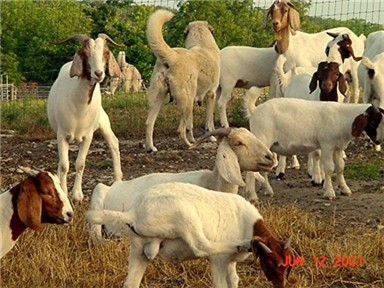 Lucky Hit's Tawny Shadow Wary watchfulness can be indicated when the Anatolian's head is level with the back or a bit higher. However, a fully raised head indicates an alert state of highly concerned watchfulness. The Anatolian head is fully raised prior to initiation of an escalated level of aggression to signal potential danger to the Anatolian's charges. Here, Shadow is clearly looking at something that concerns her! |
![]()
 Lucky Hit's Shadow Samson (left) and Lucky Hit's Shadow Kasif (Case) (right), like all my pups, were placed in the pasture with goats and other animals from about 2 1/2 weeks of age. You can see how respectfully the pups "bow" to the goats to demonstrate that they are no threat! Goats generally respond to this respectful posturing by calming down. When I see a pup whose eyes have been open less than a week "bow" or drop to the ground with a respectful demeanor, I know that pup has superior genetic behavioral responses hard-wired in their brains! One can only understand a pup's genetic behavioral hardwiring for working ability by observing that pup being raised with sheep and/or goats. This is a time consuming task. An x-ray or blood test is easy and quick. Testing for superior working ability can take years of dedicated observation and must be done with sheep and/or goats in a predator rich enviornment!!! |
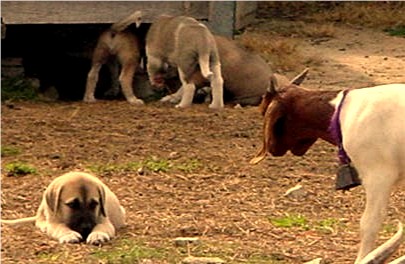 In these pictures both Sam (to the left) and Case (to the right) are signaling their submission. Note that when CASE lay completely down on the ground, the a goat became completely relaxed. This type of early and frequent flock interaction allows a guardian pup's brain to develop to it's maximum flock guardian potential. It also enhances the development of flock guardian behavioral shapes in a maturing Anatolian. |
 Anatolians properly bonded enjoy spending time with their goats and can frequently be found wandering the pasture with their charges, as seen in the Lucky Hit Anatolians at left. An Anatolian's owner is responsible for providing an environment that enhances innate bonding behaviors in their young pup. So called "breeders" who produce Anatolians without testing their Anatolians for working ability and make breeding selections for traits unrelated to working ability will eventually lose working ability in their Anatolians! While testing for hip dysplasia, thyroid testing, and show Championships is interesting, none of these things predict the dog's level or working ability! I think they focus on these things so obsessively because they've done nothing to test for the essence of the breed - the ability of the Anatolian to guard sheep and/or goats in a predator rich environment! |
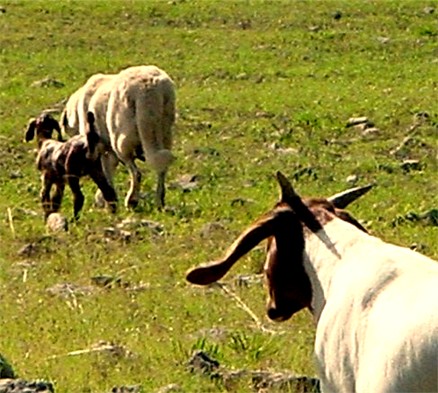 Lucky Hit's Tawny Shadow (SHADOW at right) moves with the herd accompanied by a kid who feels safe at her side. Note Shadow's lowered head and relaxed tail. Shadow's body language signals her herd that "all is well." Her proper demeanor engenders feelings of safety and comfort in her flock. When viewed from a distance, the demeanor and behavior of an Anatolian signaling "all is well" is identical to a sheep and/or goat calmly walking along with the herd. My experience is that many AKC judges dislike the demeanor of Anatolians who express this laid back, non-responsive goat-like demeanor in the ring. Just like a breeder who fails to understand how necessary these goat-like behaviors are to Anatolian breed preservation, judges who select against these behaviors in favor of "generic show-dog behaviors" are working against Anatolian breed preservation! If you truly love Anatolians, select your Anatolian pup from breeders who have diligently worked to understand and breed for superior working ability! |
![]()
![]()
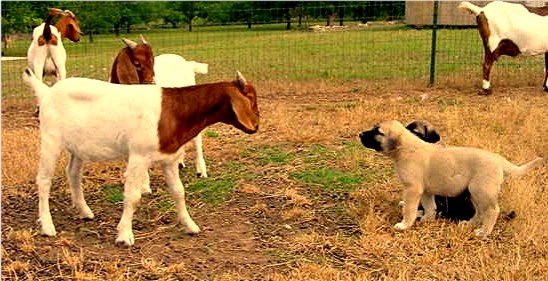 For this positive behavioral conformation to have the greatest likelihood of being expressed in Anatolians, the pup must be properly bonded during the important first 16 weeks of its life. After that critical time has passed, the bonding has less likelihood of being as close. When an Anatolian pup is fully and correctly bonded, the pup's behavioral conformation causes the pup to feel pleasure in accompanying its flock. Equally important is the pup's genetic make-up! Pups selected for generations from superior working Anatolians tend to have a much higher level of working ability than pups selected for other traits unrelated to working ability! |
 Lucky Hit Autumn Shade (SHADE) , pictured here at eight months, enjoys spending time with his goats, frequently following them around the pasture. You can see that SHADE and the goat ahead of him have stopped and are looking at something of interest. See how closely Shade's demeanor and head position match the goat ahead of him! For clear flock communication, Anatolians must mimic sheep and/or goat postures and demeanor rather than regular dog demeanor. This is why is it vital that all breeding decisions are based on superior working ability above all other traits and considerations! |
![]()
![]()
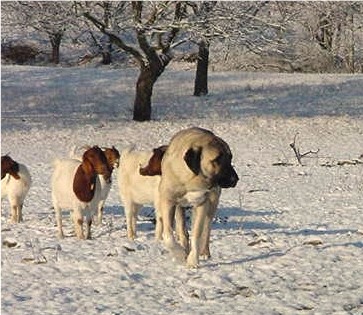 Lucky Hit's Shadow Sahara, shown here at 1 1/2 years, leads her goats when entering new pasture each day. Note how serious and watchful she is, since there are many predators in the area. Bonding like this is most successful when a pup is kept with flock animals that are neither too aggressive nor too weak. |
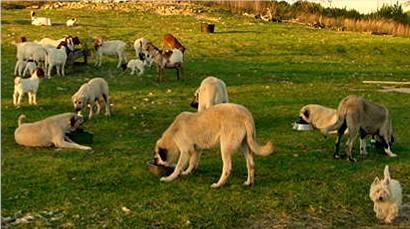 If the animals are too aggressive, they may damage a pup physically. Or the animals may be so aggressive that the pup feels abused and learns to avoid the flock. However, if a pup's "training" animals are weak and skittish, the pup may learn to play roughly with its charges or even injure them, requiring work and time to correct. The owner is responsible for placing the pup with animals of the correct level for that pup's stage of development. If the owner fails to maintain "training" animals of the correct level with the pup during the pup's development, the owner is responsible for enhancing bad behavioral conformations seen in the pup. Older Lucky Hit Anatolian pups eating in a circle with goats eating in the background. My Anatolians are taught that they can only eat from the bowl I give them and that they are not allowed to move a less dominant dog from their bowl. They are also taught to accept my little West Highland White, Sugar. |
![]()
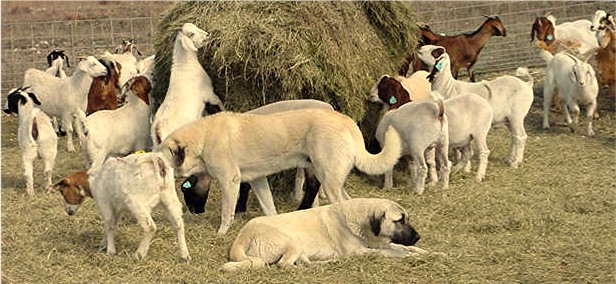 Lucky Hit's Seven of Nine (lying down) and Lucky Hit's Shadow Kasif (Case) (standing) interacting frequently with their goats. Maintaining Anatolians with a large number of flock animals in a small space results in a greater frequency of Anatolian/flock animal interactions. This increase in the frequency of interactions is beneficial for enhancing working behavioral conformations in a pup's developing brain, especially during the first crucial 16 weeks of the pup's life. It is also useful in obtaining detailed information regarding an adult Anatolian's true behavioral conformations. |
|
|
Interaction occurring early between Anatolian pups and their future charges increase the closeness of bonding. Lucky Hit's Seven of Nine enjoys the company of two of her training goats. |
![]()
 Click Picture to Return to Anatolian Main page
Click Picture to Return to Anatolian Main page